- Главная
- Разное
- Бизнес и предпринимательство
- Образование
- Развлечения
- Государство
- Спорт
- Графика
- Культурология
- Еда и кулинария
- Лингвистика
- Религиоведение
- Черчение
- Физкультура
- ИЗО
- Психология
- Социология
- Английский язык
- Астрономия
- Алгебра
- Биология
- География
- Геометрия
- Детские презентации
- Информатика
- История
- Литература
- Маркетинг
- Математика
- Медицина
- Менеджмент
- Музыка
- МХК
- Немецкий язык
- ОБЖ
- Обществознание
- Окружающий мир
- Педагогика
- Русский язык
- Технология
- Физика
- Философия
- Химия
- Шаблоны, картинки для презентаций
- Экология
- Экономика
- Юриспруденция
Что такое findslide.org?
FindSlide.org - это сайт презентаций, докладов, шаблонов в формате PowerPoint.
Обратная связь
Email: Нажмите что бы посмотреть
Презентация на тему Sustainable development
Содержание
- 2. TodayDiscussion of your groupsMarketing PresentationsWhat we mean by sustainabilityAppropriate TechnologyMarketsStakeholder analysisDiscussion
- 3. Sustainable Development DefinitionsNormative definition Development that meets
- 4. SustainabilityMajor components:EnvironmentalEconomicSocialPolitical
- 5. Environmental SustainabilityReduce, Reuse, RecycleDeveloping countries are really
- 6. Environmental SustainabilityCradle-to-Cradle ManufacturingManufacturer is responsible for the
- 7. Ford Web Site
- 8. Ford Is this for real? Is Ford really creating sustainable products?Is this “greenwashing?”Can companies be green?
- 9. Are we just making greener widgets?A systems
- 10. Economic SustainabilityWho is paying for your product?UserNGOGovernmentWill
- 11. Social SustainabilityDoes your product fit into its
- 12. Appropriate TechnologySimple, Low-cost, Local (but effective)Labor-intensive methodsLow capital costs“Junk” is goodUse, Maintenance are simpleGive some examples
- 13. Why Appropriate Technology?Socially sustainablesemi-skilled labor jobsemploys available skills, teaches new onesfits into social contextfamiliar
- 14. Why Appropriate Technology?Economically sustainableuses readily available laboravoids
- 15. Markets: what are they good for?People will
- 16. And what are they bad atSome people
- 17. Stakeholder analysisA systematic way to make sure
- 18. Why is this important?Some of these people
- 19. Stakeholder Analysis Do for all stakeholders
- 20. Скачать презентацию
- 21. Похожие презентации
TodayDiscussion of your groupsMarketing PresentationsWhat we mean by sustainabilityAppropriate TechnologyMarketsStakeholder analysisDiscussion
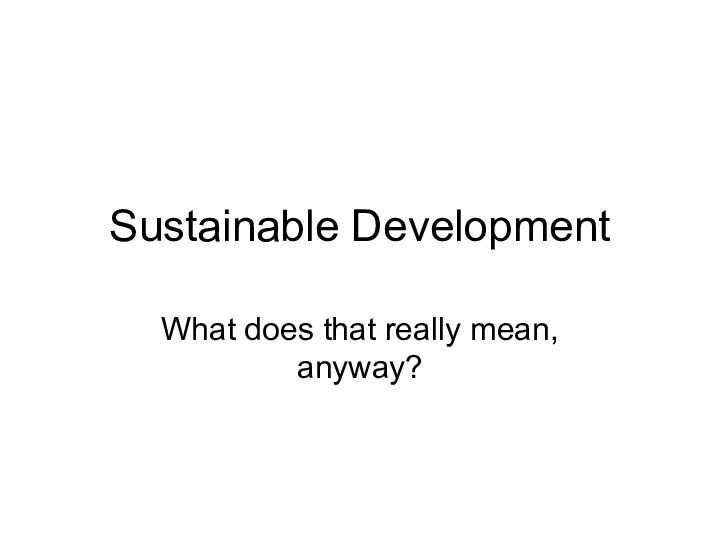
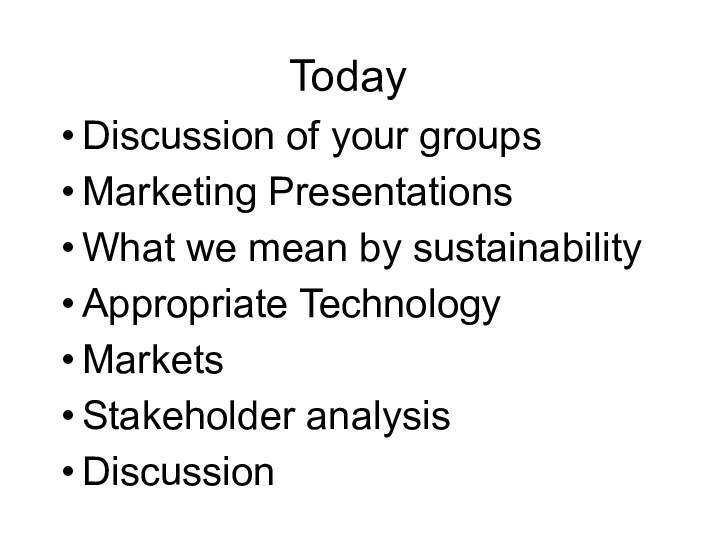

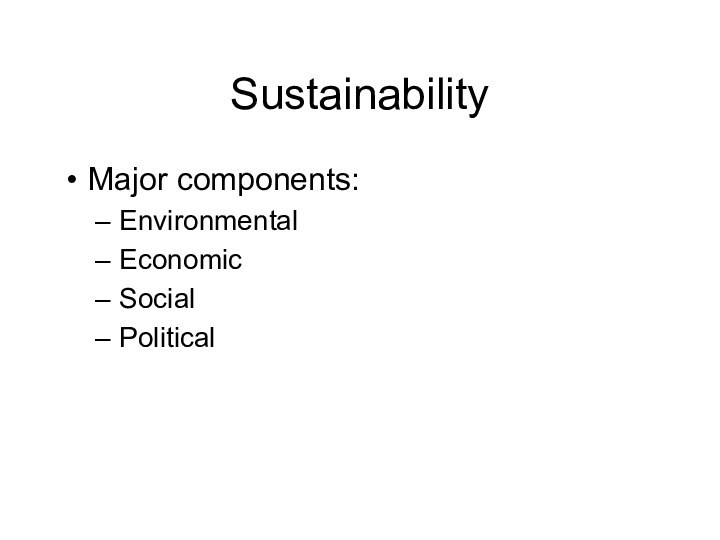




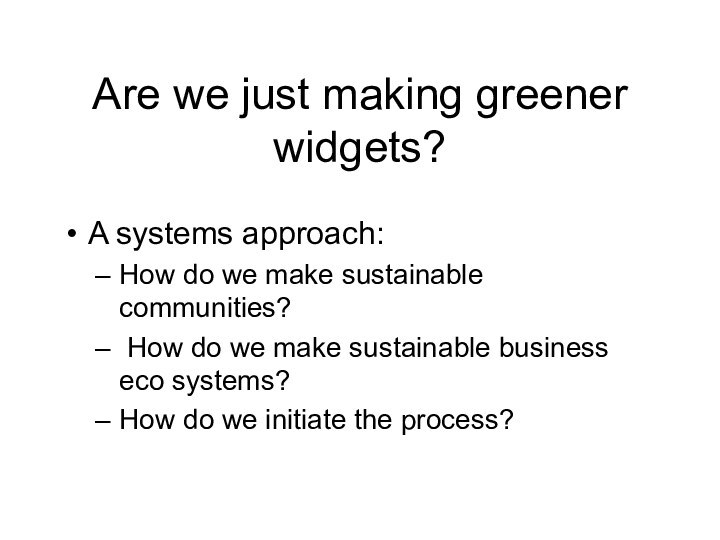

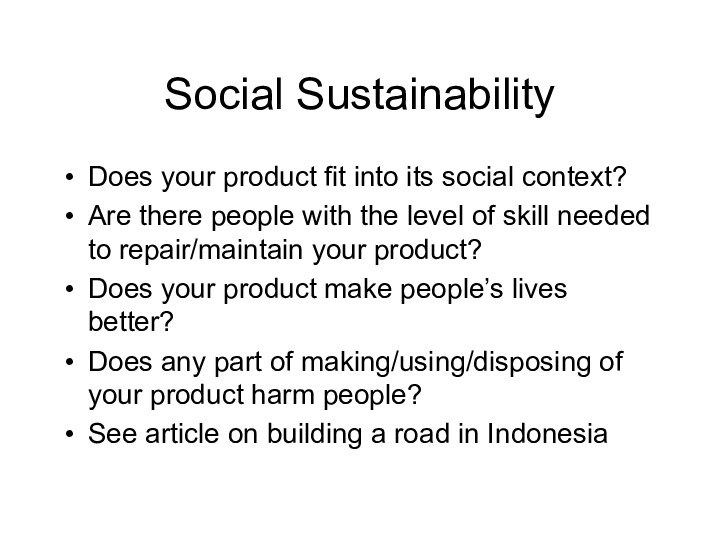
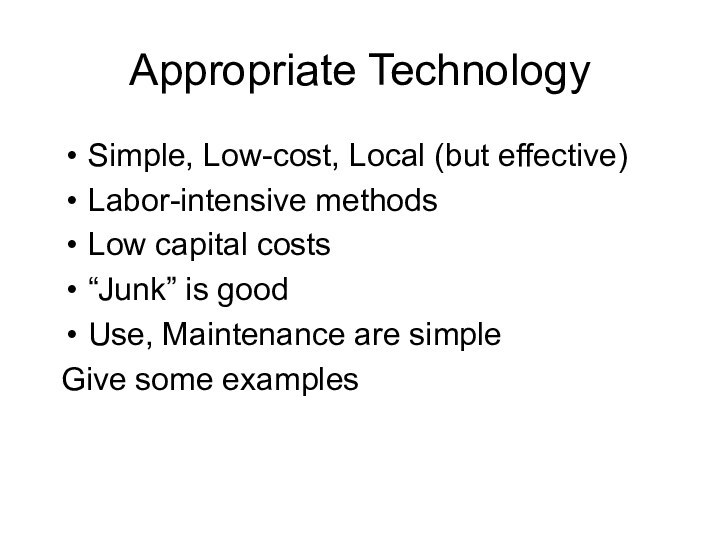


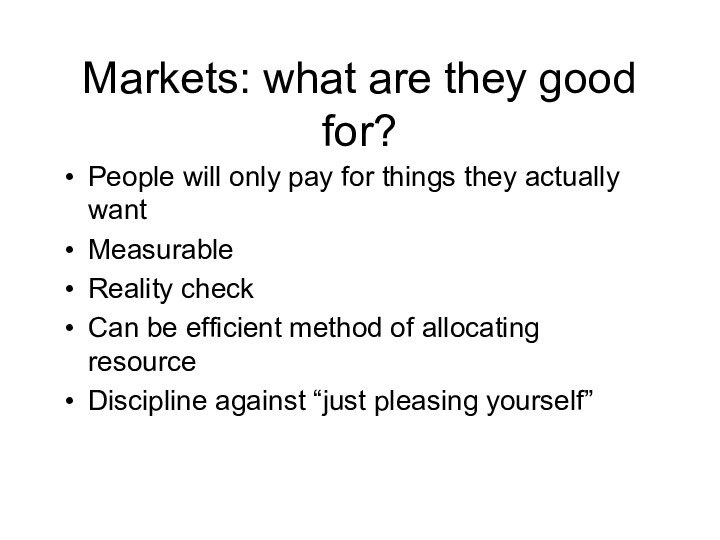
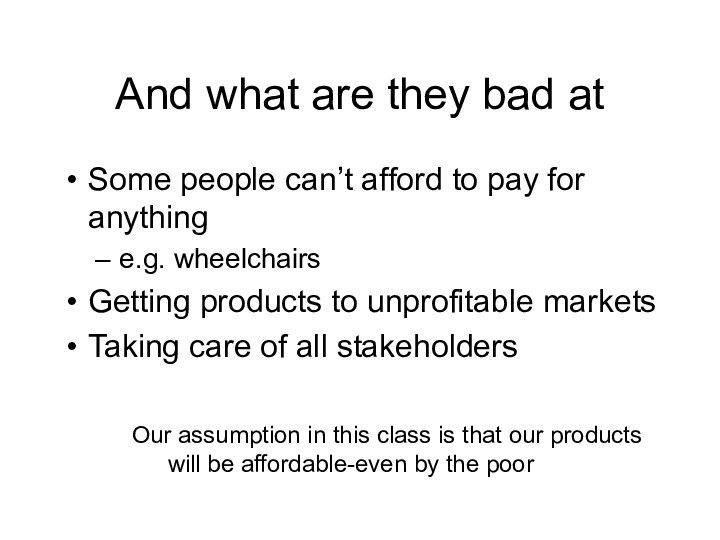




Слайд 3
Sustainable Development Definitions
Normative definition
Development that meets the
needs and aspirations of the current generation without compromising
the ability to meet those of future generations.Our definition
Development which enables individuals and communities in underdeveloped regions of the world to raise living standards through profitable products, consistent with minimizing adverse environmental effects
Слайд 5
Environmental Sustainability
Reduce, Reuse, Recycle
Developing countries are really GOOD
at this!
Is this enough in rural Guatemala?
Is this a
luxury in rural Guatemala?Does this only delay the exhaustion of resources in the developed world (see “Cradle to Grave” McDonaugh and Braungart
Eco-efficiency
Being “less bad”
Слайд 6
Environmental Sustainability
Cradle-to-Cradle Manufacturing
Manufacturer is responsible for the product
through entire life-cycle
Create products that are designed for “upcycling”
Technical
and biological “nutrient cycles”No waste, not less waste
Слайд 8
Ford
Is this for real? Is Ford really
creating sustainable products?
Is this “greenwashing?”
Can companies be green?
Слайд 9
Are we just making greener widgets?
A systems approach:
How
do we make sustainable communities?
How do we make
sustainable business eco systems?How do we initiate the process?
Слайд 10
Economic Sustainability
Who is paying for your product?
User
NGO
Government
Will they
keep paying?
Why?
What is the value your product brings?
Слайд 11
Social Sustainability
Does your product fit into its social
context?
Are there people with the level of skill needed
to repair/maintain your product?Does your product make people’s lives better?
Does any part of making/using/disposing of your product harm people?
See article on building a road in Indonesia
Слайд 12
Appropriate Technology
Simple, Low-cost, Local (but effective)
Labor-intensive methods
Low capital
costs
“Junk” is good
Use, Maintenance are simple
Give some examples
Слайд 13
Why Appropriate Technology?
Socially sustainable
semi-skilled labor jobs
employs available skills,
teaches new ones
fits into social context
familiar
Слайд 14
Why Appropriate Technology?
Economically sustainable
uses readily available labor
avoids using
scarce capital
avoids work stoppages associated with importing spare parts,
foreign expertsLarge factories in developing countries often run below capacity
Scalable on village level and village to village (consider issues of poor transportation and communication)
Слайд 15
Markets: what are they good for?
People will only
pay for things they actually want
Measurable
Reality check
Can be efficient
method of allocating resourceDiscipline against “just pleasing yourself”
Слайд 16
And what are they bad at
Some people can’t
afford to pay for anything
e.g. wheelchairs
Getting products to unprofitable
marketsTaking care of all stakeholders
Our assumption in this class is that our products
will be affordable-even by the poor
Слайд 17
Stakeholder analysis
A systematic way to make sure you
address everyone who will be affected by your product.
Слайд 18
Why is this important?
Some of these people can
affect the success of your project (government officials, prominent
citizens)Despite our mantra of making products that poor people can afford, we care about development, not just profits. But profits are the best we know of measuring the effectiveness of our products and this can be misconstrued
Слайд 19 Stakeholder Analysis Do for all stakeholders Use numeric
scores (1-10) where appropriate
Update regularly
Define clearly who the stakeholder
isDefine how important this stakeholder is for the success of the business
What precisely do I need from this stakeholder? positive contribution? Avoidance of negative?
What motivates this stakeholder? How is this stakeholder rewarded?
How to reach the Stakeholder? Influencers?
How can I get the stakeholder to help me in my goal?
What do I do if the stakeholder is negative (risk reduction)?
This is my take. Feel free to change at will





























